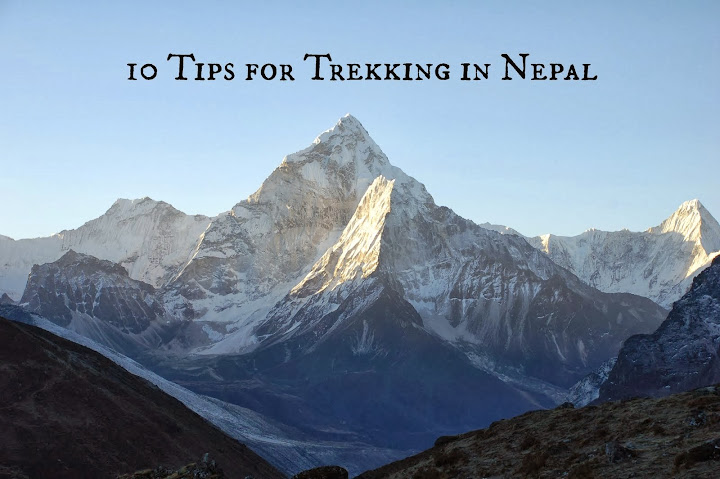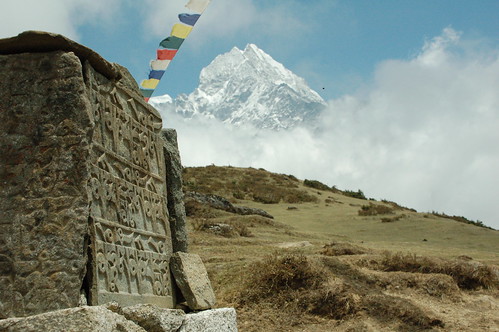In May 2010, my family and I went to Nepal for a month. Over the course of that month, we traveled all across Nepal, but the highlight—for me, anyways—was trekking in the beautiful Khumbu region. Unfortunately we ran into several problems—things that could have been solved as easy as bringing an extra fifty dollars in cash. So I figured that I would share my hard-earned knowledge and give you a few tips for trekking in Nepal.

1. Bring warm clothing
Yes, this one is kind of obvious, but I decided it was a core element of trekking, so here it is anyway. A warm, wool sweater, accompanied by a lighter, yet still chill-proof jacket is good for cold weather, and especially good for layering in really icy weather. And don't forget a good old rain jacket, too. A warm hat that covers your ears and a pair of thick gloves are key (we bought some really good quality hats and gloves in Lukla)! A scarf is also a good thing to have, along with warm—wool is suggested—socks, and a pair of good, sturdy hiking boots.
2. Equipment
I could go on forever listing equipment that would be nice to have, but that would take too long to read and add too much weight to your pack. A hiking stick, headlamp, and maybe a camera would be a few basic things to bring, along with disposable wipes for emergency bathroom trips. Don't bother bringing a hiking stick from home—buy one in Nepal at the start of your trek. That will most likely save both money and room.

Window onto Namche, Nepal
3. Don't bring a lot of useless things
Don't pack a library of books—you only have a certain amount of space in that backpack of yours. One or two books are plenty. Besides, you want time to be able to take a look around, interact with the people, etc. Don't bring everything in your makeup drawer, it doesn't really matter how you look while trekking. Besides, it wouldn't be fun carrying around a ton of makeup, would it? Every ounce counts!
4. Bring cash
First of all, there are no ATMs, and very few places along your way will accept credit cards. Next, lodges may be cheap, yes, but sometimes the food can cost more than it does in the United States, and you may want to pick up a souvenir here and there. Plan for it—bring extra cash in case you underestimated the cost of your trip. Also make sure that you change most of your currency into Nepali rupees before you head into the mountains.
5. Be flexible
Give yourself a few extra days while planning your trek—you never know what kind of weather will greet you a few days into your trek. Be prepared to take advantage of bad weather that you can't trek in, and don't panic. If you have a few days extra, why not relax and enjoy the day (or days) of rest?
6. First Aid
Of course you want to bring your typical first aid kit, but besides that there are several other things you may not think about. For starters, anti-diarrhea tablets and water purifier tablets. Malaria pills, headache and stomachache medicine are also great things to have. Blisters are a major problem for the average trekker, causing awful pain while trying to hike, so I suggest bringing some kind of blister bandage. But don't wait until you have the blister. When you think you may be getting a blister, stop and put on a blister bandage in efforts to keep it from blistering.
7. Water
Water, as you can probably guess, is extremely important while trekking. You do not want to get dehydrated. My suggestion is to bring at least two water bottles per person. And—if all else fails—in tip 6 I suggested bringing water purifier tablets, which will help in case you run out of water. A trick we used while trekking was to get a water bottle (or thermos), and have the owners of the lodge boil some water for us. Then we would fill our water bottle with the hot water and stick it at the end of our beds to help heat us on cold nights. By the time we woke up, the water would be cold, purified, and ready for our next day trekking.
8. Pack light, pack smart
Though you may want to call me disgusting, I suggest you only bring two or three pairs of clothes. First of all, it saves room, and second, there's no point in changing every day, just to get all sweaty and gross the next day anyway. Your shoes will stink no matter your efforts to change socks every day—sorry. Also, if it decides to start pouring rain, you may want to pack some of your clothes into oversized ziploc bags, in case water leaks into your backpack. It also can save room if you happen to be packing a lot.
9. Food facts
Not all foods are good to eat while trekking. I could go on for a while about this, but for now I'll cover some basics. Try not to eat any uncooked vegetables, especially something like a salad. Most vegetables are almost 80% water, and the water is generally not pure. Also, though it may sound tempting, a bowl of curry or a cup of nice hot cocoa is sometimes not a great idea either. The water in foods like that is not always purified or boiled properly. If you want a hot drink, chai is a great substitute for hot chocolate, and coffee is almost always served at lodges or restaurants.

10. Be Respectful
Remember whose land you are technically intruding upon. Treat the locals with respect, and make sure to honor their religion, no matter your beliefs. You are guests—as were we—in this beautiful land. Remember that.
Have fun! May your travels be filled with wonder and excitement, and please don't fall off any cliffs. Keep in mind, these are tips that would have helped us in our trek. Your experiences may be quite different than ours, and more tips may be necessary. Write about it! Make someone else's experience better. Do you have any tips to share?
Jackson Duckworth is a member of the Youth Travel Blogging Mentorship Program
All photos courtesy and copyright Jackson Duckworth
